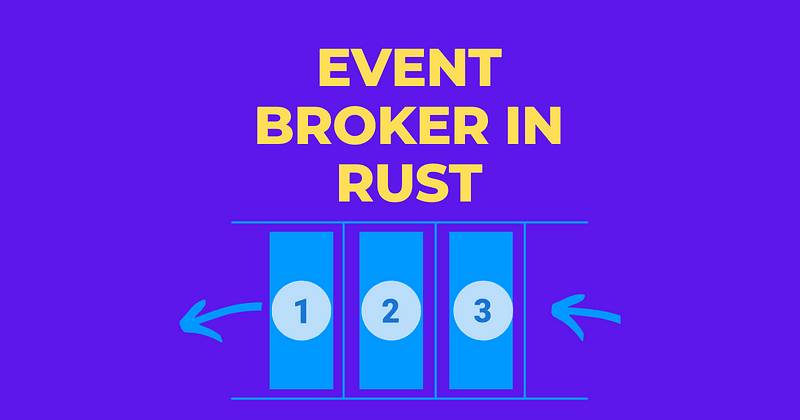Hey there, Rustacean! 🦀
Asynchronous programming in Rust can seem complex at first glance, especially when you’re trying to maximize performance while ensuring safety. But with the right patterns and practices, it becomes manageable and even enjoyable. In this article, we’ll explore some of the essential asynchronous design patterns in Rust, breaking down their use cases and benefits. Whether you’re new to async in Rust or looking for a refresher, this guide aims to provide clarity and direction. Let’s dive in!
1. Event-driven Architecture
In event-driven architectures, the flow of the program is determined by events. Rust’s asynchronous ecosystem, built around Futures and Streams, naturally supports event-driven designs.
Example:
Using the tokio runtime and its event loop, one can asynchronously listen for incoming TCP connections and handle them:
use tokio::net::TcpListener; #[tokio::main] async fn main() { let listener = TcpListener::bind("127.0.0.1:8080").await.unwrap(); loop { let (socket, _) = listener.accept().await.unwrap(); tokio::spawn(async move { // Handle socket }); } }2. Backpressure Management
Backpressure is a mechanism to handle situations where a system is overloaded with more data than it can process. Rust’s asynchronous channels often come with built-in backpressure support.
Example:
Using tokio::sync::mpsc channels, if the receiver can’t keep up with the sender, the channel fills up, and sending operations become asynchronous, naturally introducing backpressure.
Here’s a simple example demonstrating backpressure management:
use tokio::sync::mpsc; use tokio_stream::wrappers::ReceiverStream; use tokio_stream::StreamExt; const BUFFER_SIZE: usize = 5; async fn produce(tx: mpsc::Sender<i32>) { for i in 0..100 { if tx.send(i).await.is_err() { println!("Receiver dropped, stopping producer."); break; } println!("Produced {}", i); } } async fn consume(mut rx: ReceiverStream<i32>) { while let Some(item) = rx.next().await { println!("Consumed {}", item); tokio::time::sleep(tokio::time::Duration::from_millis(100)).await; // Simulate slower consumption } } #[tokio::main] async fn main() { let (tx, rx) = mpsc::channel(BUFFER_SIZE); let rx_stream = ReceiverStream::new(rx); tokio::spawn(async move { produce(tx).await }); consume(rx_stream).await; }In this example:
- We set a buffer size of 5 for our channel.
- The producer generates numbers quickly and sends them to the channel.
- The consumer reads from the channel but processes the numbers at a slower rate.
- Once the channel buffer fills up, the producer will await until there’s room in the buffer, creating a natural backpressure mechanism.
- If the consumer is dropped or goes out of scope, the producer will stop producing as indicated by the error on send.
This approach allows the consumer to effectively signal the producer about its current processing capability, ensuring system equilibrium under varying loads.
3. Lazy Evaluation with Futures
In Rust, Futures are lazy by default. They don’t do any work until they’re polled. This allows for patterns where computations are delayed until they’re actually needed.
Example:
async fn expensive_computation() -> i32 { // ... Some expensive async work 42 } let computation = expensive_computation(); // Nothing happens yet. let result = computation.await; // Now the computation is triggered.4. Actor Model with actix
The actor model is a design pattern where entities (actors) communicate exclusively through messages, ensuring that only one actor processes a message at a time. The actix framework brings the actor model to Rust.
Example:
With actix, you can define actors and messages, and then send asynchronous messages to those actors for processing.
use actix::prelude::*; struct MyActor; impl Actor for MyActor { type Context = Context<Self>; } struct MyMessage; impl Message for MyMessage { type Result = (); } impl Handler<MyMessage> for MyActor { type Result = (); fn handle(&mut self, _msg: MyMessage, _ctx: &mut Context<Self>) { println!("Message received"); } }5. State Machine Transitions with async
Asynchronous operations can be modeled as state machines. Each .await point can be viewed as a transition between states.
Example:
A simple async function that fetches and processes data can be seen as transitioning between a “fetching” state and a “processing” state.
async fn fetch_and_process() { let data = fetch_data().await; // Transition to fetching state process_data(data).await; // Transition to processing state }6. Callback Chains with Futures
In scenarios where you want to trigger another asynchronous action after one completes, you can chain futures using combinators like then, and_then, and or_else.
Example:
Using the futures crate, you can create a chain of callbacks:
use futures::future::FutureExt; async fn fetch_data() -> Result<String, &'static str> { Ok("Data".to_string()) } fetch_data() .then(|res| async { match res { Ok(data) => println!("Data: {}", data), Err(err) => println!("Error: {}", err), } }) .await;7. Error Handling in Asynchronous Flow
Rust has a strong emphasis on expressive error handling with the Result and Option types. These patterns extend seamlessly into the async world.
Example:
Using the ? operator in asynchronous functions to propagate errors:
async fn fetch_data() -> Result<String, &'static str> { // ... Some async operations Ok("Data".to_string()) } async fn process_data() -> Result<(), &'static str> { let data = fetch_data().await?; // ... Process the data Ok(()) }8. Resource Cleanup with Drop in Asynchronous Context
Ensuring proper cleanup of resources, especially in async contexts, can be challenging. In Rust, the Drop trait can be combined with asynchronous patterns for effective resource management.
Example:
Using the Drop trait to ensure an async resource, like a connection, is closed properly:
struct AsyncConnection; impl AsyncConnection { async fn close(&self) { // Async cleanup operations } } impl Drop for AsyncConnection { fn drop(&mut self) { // Use a runtime to perform async cleanup if needed let runtime = tokio::runtime::Runtime::new().unwrap(); runtime.block_on(self.close()); } }9. Combinatorial Patterns with Futures
Asynchronous workflows often involve combining multiple futures. Combinatorial patterns allow developers to control the concurrency and execution order of these futures.
Example:
Using the join! macro to await multiple futures concurrently:
use futures::join; async fn task_one() -> i32 { 1 } async fn task_two() -> i32 { 2 } async fn main() { let (result_one, result_two) = join!(task_one(), task_two()); println!("Results: {}, {}", result_one, result_two); }10. Middleware Pattern in Asynchronous Web Servers
Asynchronous web servers in Rust, such as warp or rocket, often support a middleware pattern. Middlewares are components that process requests and responses, forming a chain of processing steps.
Example:
Using warp to create a chain of middlewares:
use warp::Filter; #[tokio::main] async fn main() { let log = warp::log("my_app"); let routes = warp::any() .map(|| warp::reply::html("Hello, world!")) .with(log); warp::serve(routes).run(([127, 0, 0, 1], 3030)).await; }11. Stream Processing and Transformation
Streams in Rust represent sequences of values produced asynchronously. They can be thought of as asynchronous iterators. Libraries such as futures and tokio-stream offer powerful tools to work with streams, enabling patterns for processing, filtering, and transforming data on-the-fly.
Example:
Transforming and filtering an async stream using tokio-stream:
use tokio_stream::StreamExt; async fn get_stream() -> impl tokio_stream::Stream<Item = i32> { tokio_stream::iter(vec![1, 2, 3, 4, 5]) } async fn process_stream() { let mut stream = get_stream(); let transformed = stream.filter(|&x| x % 2 == 0).map(|x| x * 2); transformed.for_each(|item| { println!("{}", item); futures::future::ready(()) }).await; }12. Fan Out, Fan In Patterns
The “Fan Out, Fan In” pattern involves starting multiple async tasks (fan out) and then combining their results into a single, aggregated result (fan in).
Example:
Using tokio and futures to fan out multiple tasks and then aggregate their results:
use futures::future::join_all; async fn do_work(item: i32) -> i32 { // Some async operations... item * 2 } async fn main() { let items = vec![1, 2, 3, 4, 5]; let tasks: Vec<_> = items.into_iter().map(do_work).collect(); let results: Vec<i32> = join_all(tasks).await; let sum: i32 = results.iter().sum(); println!("Total: {}", sum); }13. Timeout and Retry Patterns
In an asynchronous system, operations might not always complete in a timely manner. The timeout pattern ensures that an operation doesn’t take longer than a specified duration. Additionally, the retry pattern attempts an operation again if it fails.
Example:
Using tokio to implement both timeout and retry patterns:
use tokio::time::{timeout, Duration}; async fn potentially_slow_operation() -> Result<i32, &'static str> { // Some async operations... Ok(42) } async fn with_timeout_and_retry() -> Result<i32, &'static str> { const RETRY_COUNT: u32 = 3; for _ in 0..RETRY_COUNT { match timeout(Duration::from_secs(5), potentially_slow_operation()).await { Ok(result) => { if result.is_ok() { return result; } } Err(_) => { println!("Operation timed out, retrying..."); } } } Err("Failed after multiple retries") }14. Rate Limiting with Asynchronous Tasks
Rate limiting is a strategy to control the amount of requests or operations a system processes over a given time span. In asynchronous systems, rate limiting ensures that resources are not overwhelmed by too many concurrent tasks.
Example:
Using tokio‘s Semaphore for rate limiting:
use tokio::sync::Semaphore; async fn limited_task(semaphore: &Semaphore) { let _permit = semaphore.acquire().await; // ... Some async operations } async fn main() { const MAX_CONCURRENT_TASKS: usize = 5; let semaphore = Semaphore::new(MAX_CONCURRENT_TASKS); let tasks: Vec<_> = (0..10).map(|_| limited_task(&semaphore)).collect(); futures::future::join_all(tasks).await; }15. Asynchronous Generators
Rust also supports asynchronous generators which allow for producing multiple values over time, similar to streams.
Example:
Using async generators:
use futures::stream::StreamExt; async fn async_range(from: i32, to: i32) -> impl tokio_stream::Stream<Item = i32> { tokio_stream::iter((from..to).map(|x| async move { x })) } async fn main() { let mut stream = async_range(1, 5); while let Some(value) = stream.next().await { println!("{}", value); } }16. Shared State in Asynchronous Code
Sharing state across asynchronous tasks in a safe manner is a common challenge. Rust’s ownership model, combined with async-aware synchronization primitives, offers a solid solution.
Example:
Using tokio‘s RwLock to share and modify state:
use tokio::sync::RwLock; use std::sync::Arc; async fn increment_counter(counter: Arc<RwLock<i32>>) { let mut lock = counter.write().await; *lock += 1; } async fn main() { let counter = Arc::new(RwLock::new(0)); let tasks: Vec<_> = (0..10).map(|_| increment_counter(counter.clone())).collect(); futures::future::join_all(tasks).await; let final_count = counter.read().await; println!("Final count: {}", *final_count); }
Wrapping Up
With each layer of Rust’s asynchronous ecosystem, we uncover a wealth of design patterns and practices designed to offer both safety and performance. These patterns are not just mere recipes to follow, but rather they signify deeper insights into the challenges and solutions in asynchronous computing.
Ultimately, the power of Rust’s asynchronous ecosystem lies not just in the patterns themselves but in the promise they offer: the ability to build reliable, high-performance systems that are maintainable over time. Embrace this potential, continue exploring, and let the Rust journey continue!
Check out some interesting hands-on Rust articles!
🌟 Developing a Fully Functional API Gateway in Rust — Discover how to set up a robust and scalable gateway that stands as the frontline for your microservices.
🌟 Implementing a Network Traffic Analyzer — Ever wondered about the data packets zooming through your network? Unravel their mysteries with this deep dive into network analysis.
🌟 Building an Application Container in Rust — Join us in creating a lightweight, performant, and secure container from scratch! Docker’s got nothing on this. 😉
🌟 Implementing a P2P Database in Rust: Today, we’re going to roll up our sleeves and get our hands dirty building a Peer-to-Peer (P2P) key-value database.
🌟 Building a Function-as-a-Service (FaaS) in Rust: If you’ve been exploring cloud computing, you’ve likely come across FaaS platforms like AWS Lambda or Google Cloud Functions. In this article, we’ll be creating our own simple FaaS platform using Rust.
🌟 Building an Event Broker in Rust: We’ll explore essential concepts such as topics, event production, consumption, and even real-time event subscriptions.
Read more articles about Rust in my Rust Programming Library!
Visit my Blog for more articles, news, and software engineering stuff!
Follow me on Medium, LinkedIn, and Twitter.
Leave a comment, and drop me a message!
All the best,
Luis Soares
CTO | Tech Lead | Senior Software Engineer | Cloud Solutions Architect | Rust 🦀 | Golang | Java | ML AI & Statistics | Web3 & Blockchain











